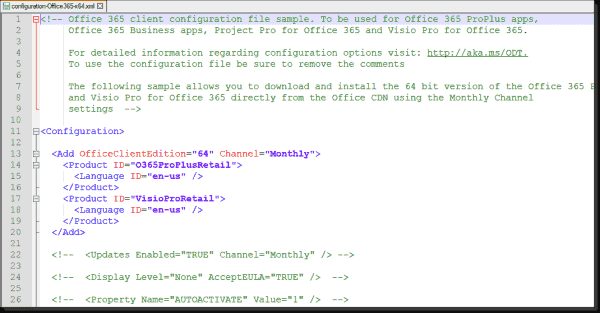How To Install Only Work And Excel From Windows Office
When yous commencement the setup of Function 2016 or 2019, information technology installs all the applications based on some predefined settings. This behavior is oftentimes undesirable. Therefore, you can customize the installation using the Office Deployment Tool (ODT) and a configuration file.
- Author
- Recent Posts
![]()
Microsoft no longer ships newer versions of Office with an MSI installer, but instead uses the Click-to-Run technique. Therefore, the setup program downloads the installation files from the cyberspace. Still, these are also available over local information media as usual.

Microsoft Office Click to Run setup in Task Managing director
No options for a standard setup ^
Unlike a conventional installation, Click-to-Run by default does non permit yous to select which applications you want to install or specify the path where you want to salvage them.

The Click to Run setup volition install all Role applications without giving the user a selection
However, if you want to customize the setup, Microsoft offers the ODT for this purpose. It consists of an .exe file that unpacks its contents into the selected directory when executed.

Content of the Office Deployment Tool
If y'all want to bypass this procedure and the corresponding User Account Control (UAC) prompt, yous can also extract the contained files straight with seven-Nil.
Contents of the ODT ^
The parcel consists of serveral files: the setup.exe, example configuration files, and a text file with the end-user license agreement (EULA). To prepare for a customized installation, you lot accept to create a new configuration file or edit the supplied template in the next step.

One instance configuration delivered with the Office Deployment Tool
Information technology is bachelor in XML format and accepts a handful of elements to control the setup. Under "Configuration" an "Add" node is required. Its aspect "OfficeClientEdition" (with values "32" or "64") determines whether to install the 32- or 64-chip version.
Specify the source path ^
The aspect "SourcePath" points where to call back the installation files. If yous accept mounted the ISO file as a virtual DVD, yous specify the root directory of the drive here (for example "D:\"):
<Add together OfficeClientEdition="32" SourcePath="D:\">
Alternatively, yous tin can copy the installation media to a share in the network and enter the universal naming convention (UNC) path.
As a kid node of Add, the configuration expects 1 or more Product elements. These do not describe the individual applications, just the stock-keeping units (SKUs) of Part using the ID aspect. Allowed values for Office 2016 and 365 are, for example:
- O365ProPlusRetail
- O365BusinessRetail
- VisioProRetail
- ProjectProRetail
- AccessRuntimeRetail
- LanguagePack
Office 2019 supports the following strings, amid others:
- ProPlus2019Volume
- Standard2019Volume
- ProjectPro2019Volume
- ProjectStd2019Volume
- VisioPro2019Volume
- VisioStd2019Volume
This support document contains the full list of all product IDs the ODT accepts.
Excluding certain Office applications ^
Some other kid element of Production determines which applications not to install. For each program you would like to practise without, y'all insert such an element and specify its name in the attribute ID, for example:
<ExcludeApp ID="Access" />
Supported values for the applications are:
- Access
- Excel
- Groove
- Lync
- OneDrive
- OneNote
- Outlook
- PowerPoint
- Publisher
- Word
Groove also covers OneDrive for Business, and Lync covers Skype for Business concern.

Installation of Function 2019 is limited to the four core applications
More options ^
In addition to this core configuration, the ODT also supports several other options. With these, y'all can acknowledge the EULA automatically or specify which channel to use for future updates.
A useful setting allows y'all to pin the Office applications to the taskbar. Notwithstanding, this just works nether Windows 7 and 8.1; in Windows 10 it has no result.
The Microsoft Website has complete documentation for all supported settings.
Configuration case ^
A sample configuration for installing from local media could await similar this:
<Configuration> <Add together OfficeClientEdition="32" SourcePath="D:\"> <Product ID="O365ProPlusRetail"> <Language ID="de-de" /> <ExcludeApp ID="Publisher" /> <ExcludeApp ID="Admission" /> <ExcludeApp ID="OneDrive" /> <ExcludeApp ID="Groove" /> <ExcludeApp ID="Lync" /> <ExcludeApp ID="OneNote" /> </Product> </Add together> <Updates Enabled="Truthful" Channel="Wide" /> <Display Level="None" AcceptEULA="TRUE" /> <!-- <Property Name="AUTOACTIVATE" Value="1" /> --> <Property Name="PinIconsToTaskbar" Value="Truthful" /> </Configuration>
Running a custom setup ^
In one case the configuration file contains all desired settings, you lot can start the ODT. Launch the setup.exe from the downloaded ODT archive.
The command looks similar this:
setup.exe /configure configuration.xml

Starting the ODT with a custom installation
After a curt preparation phase, the tool displays the icons of the programs information technology will install.
Removing applications ^
If you have installed unwanted Office components, either because yous have not excluded them in the configuration file or because you have executed the standard setup, you lot cannot uninstall them via the control panel. Uninstalling them via the control panel volition remove Function entirely.
However, it is not necessary to remove the entire package and then reinstall the desired programs. Instead, you lot can use the ODT and simply add the programs you want to uninstall under ExcludeApp in the configuration file.
Subscribe to 4sysops newsletter!
The subsequent execution of setup.exe will then remove all applications you have already installed merely excluded in the configuration file.
Source: https://4sysops.com/archives/install-only-selected-office-applications-using-the-office-deployment-tool/
Posted by: vanarsdalegagainfoute.blogspot.com


0 Response to "How To Install Only Work And Excel From Windows Office"
Post a Comment